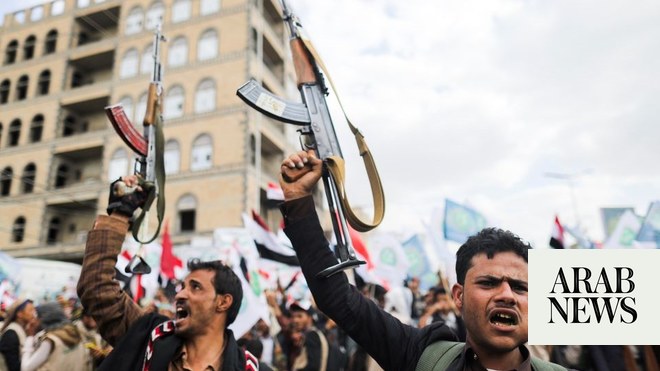
The efforts to resume the UN-led peace talks on Yemen passed through Muscat again this week. The recently appointed UN special envoy to Yemen, Martin Griffiths, met with a Houthi militia delegation and senior officials from the General People’s Congress, the party of both late president Ali Abdullah Saleh and current president Abed Rabbo Mansour Hadi. Griffiths had previously met with Yemen’s internationally recognized government in Riyadh.
Griffiths has extensive experience in negotiations and conflict resolution, including as advisor to three UN special envoys for Syria. His appointment, coupled with recent signs of war fatigue and reports of secret talks between the Arab coalition and the Houthis, seems to have raised hopes that the peace process aimed at ending this four-year conflict could be successfully revived.
Following the Muscat meetings, Dr. Abu Bakr Al-Qirbi, Yemen’s Foreign Minister between 2001 and 2014, praised on Twitter the new UN envoy’s in-depth preparation and understanding of the crisis and the obstacles to resolving it.
Soon after Muscat, the UN envoy was also set to meet Aidarus Al-Zubaidi, the leader of the Southern Transitional Council, in Abu Dhabi. This shows a preoccupation not to neglect important players. Ignoring the southern issue and the body representing the renewed separatist ambitions in the south has been a shortcoming of previous efforts to stabilize the situation on the ground.
But a reality check about the challenges ahead and the limits of what one individual can achieve arrived soon after Griffiths’ appointment. While on his first visit to Sanaa on March 25, the Houthi militias fired seven ballistic missiles — the largest number launched in a single day since the beginning of the conflict — at Riyadh and three other Saudi cities.
This intensification of ballistic missile attacks on Saudi Arabia, most of which continue to be intercepted by Saudi air defense forces, came after confirmation by a UN panel of experts that Iran has been providing military and logistical support to the Houthis, including ballistic missile technology. The Iranian support of the Zaidi revivalist group’s missile capabilities — something the Arab coalition has long been aware of — is particularly worrying since it goes far beyond the epithet of “proxy war.” There is also widespread evidence of Hezbollah presence in Yemen, mostly with an advisory role to the Houthis.
How can there be a Yemen peace deal when Houthis have a trove of ballistic missiles?
Dr. Manuel Almeida
The timing of the missile launches coincided with the UN envoy’s first visit to the Houthi-controlled Yemeni capital. This has been interpreted by experts and officials knowledgeable with the matter in two ways. One perspective is that, with a new round of negotiations on the agenda and on the third anniversary of the Saudi-led intervention, the Houthis wanted to display military strength to build some leverage.
The other interpretation, which carries a more pessimistic reading of the peace talks’ prospects of success, sees the missile launches as a rebuke by the Iran-backed militias of UN Security Council resolution 2216. Among various other de-escalation measures, this resolution — a cornerstone of the roadmap for peace — calls for the Houthis to “relinquish all additional arms seized from military and security institutions, including missile systems.” It also calls for the militant group to “refrain from any provocation or threats to neighboring states, including through acquiring surface-to-surface missiles, and stockpiling weapons in any bordering territory of a neighboring state.”
A third possibility, which does not exclude the first two, is that the ongoing missile launches are retaliatory acts by the militia, led by Abdul-Malik Al-Houthi, for various setbacks it has suffered in recent weeks on the battlefront and in the ever-shifting alliances on the ground. Al-Houthi’s recent harsh criticism of Yemen’s tribes and their untrustworthiness was a clear indication of the militia’s increasing isolation within Yemen.
As Griffiths laid out last month, just ahead of his regional tour, the keys to guiding the peace process are the GCC initiative and its implementation mechanism, the outcomes of the National Dialogue Conference, UN resolution 2216, and other relevant UN Security Council resolutions. Specifically, the calls contained in resolution 2216 for the Houthis to withdraw from the cities and areas seized since the beginning of the conflict and to disarm have naturally been a source of contention. On his last briefing to the UN Security Council, the previous UN envoy to Yemen, the Mauritanian Ismail Ould Cheikh Ahmed, said a peace deal had collapsed when the Houthis rejected the terms regarding withdrawal and disarmament, describing them as “unfair.”
These demands have lately been subject to some criticism on the grounds that they fail to reflect the reality of the conflict. Another criticism levelled at making resolution 2216 a critical part of the road map for peace is that it forces the Houthis to disarm while many other groups, from tribes to Al-Islah and Al-Qaeda, will remain heavily armed. These criticisms, however, are a gross misinterpretation of what this resolution calls for and of the causes of the conflict. The resolution does not demand the Houthis relinquish all weapons — something that in Yemen would be impossible to execute — but to return all heavy weaponry seized from the Yemeni army and all missile systems.
From the Saudi perspective, there can be no settlement if an ally of Tehran increasingly looking like a copy of Lebanon’s Hezbollah has a trove of ballistic missiles in its arsenal sitting right next to the Saudi border, and also with Abu Dhabi within reach. The fact this has been the primary justification for the Arab coalition’s intervention is often missed.
• Dr. Manuel Almeida is a political analyst and consultant focusing on the Middle East. Twitter: @_ManuelAlmeida









